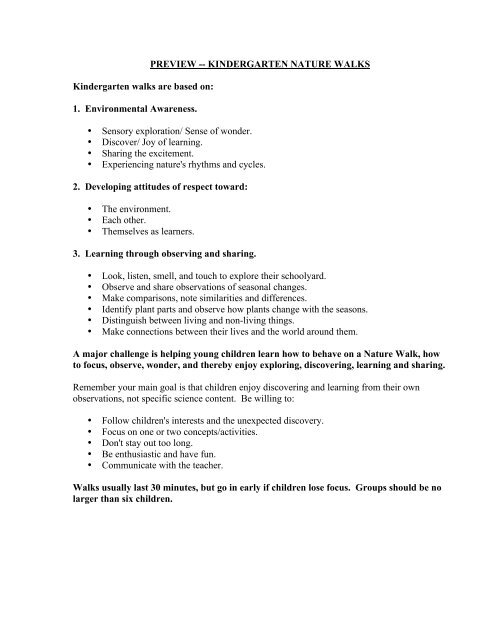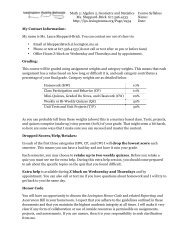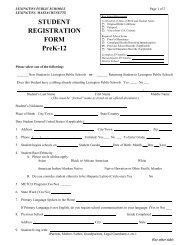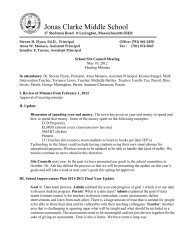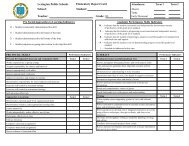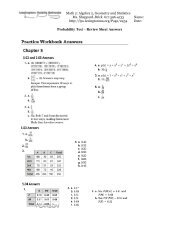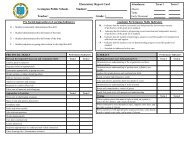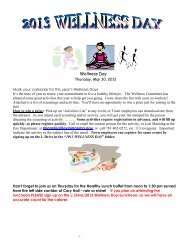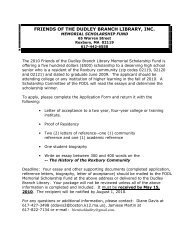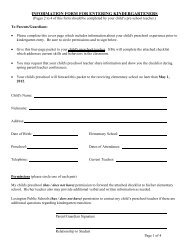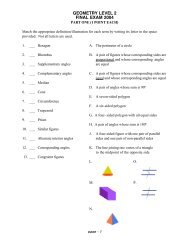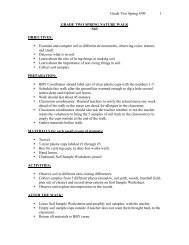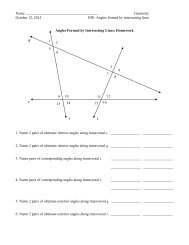Fall Big Backyard Walk - Lexington Public Schools
Fall Big Backyard Walk - Lexington Public Schools
Fall Big Backyard Walk - Lexington Public Schools
Create successful ePaper yourself
Turn your PDF publications into a flip-book with our unique Google optimized e-Paper software.
Kindergarten walks are based on:<br />
1. Environmental Awareness.<br />
PREVIEW -- KINDERGARTEN NATURE WALKS<br />
• Sensory exploration/ Sense of wonder.<br />
• Discover/ Joy of learning.<br />
• Sharing the excitement.<br />
• Experiencing nature's rhythms and cycles.<br />
2. Developing attitudes of respect toward:<br />
• The environment.<br />
• Each other.<br />
• Themselves as learners.<br />
3. Learning through observing and sharing.<br />
• Look, listen, smell, and touch to explore their schoolyard.<br />
• Observe and share observations of seasonal changes.<br />
• Make comparisons, note similarities and differences.<br />
• Identify plant parts and observe how plants change with the seasons.<br />
• Distinguish between living and non-living things.<br />
• Make connections between their lives and the world around them.<br />
A major challenge is helping young children learn how to behave on a Nature <strong>Walk</strong>, how<br />
to focus, observe, wonder, and thereby enjoy exploring, discovering, learning and sharing.<br />
Remember your main goal is that children enjoy discovering and learning from their own<br />
observations, not specific science content. Be willing to:<br />
• Follow children's interests and the unexpected discovery.<br />
• Focus on one or two concepts/activities.<br />
• Don't stay out too long.<br />
• Be enthusiastic and have fun.<br />
• Communicate with the teacher.<br />
<strong>Walk</strong>s usually last 30 minutes, but go in early if children lose focus. Groups should be no<br />
larger than six children.
OBJECTIVES:<br />
KINDERGARTEN FALL NATURE WALK OVERVIEW<br />
Plants and Seasonal Changes<br />
• Explore the schoolyard by looking, listening, smelling, and touching.<br />
• Observe and share signs of seasonal change in plants.<br />
• Identify plant parts.<br />
• Make comparisons, note similarities and differences.<br />
PREPARATION:<br />
Kindergarten <strong>Fall</strong><br />
• Schedule walk from mid-September to early October.<br />
• <strong>Walk</strong> should last about 30 minutes.<br />
• Schedule walk first thing in the morning before other classes come out for recess.<br />
MATERIALS:<br />
• Bug box (for the unexpected discovery).<br />
• String circles, one per two students.<br />
• Trowel.<br />
• Hand lenses (1 for each child).<br />
• Plastic bags for leaf and/or seed collections* (one per group).<br />
• Clipboard, pencil.<br />
• Signs of <strong>Fall</strong> <strong>Walk</strong> Report<br />
ACTIVITIES:<br />
• Close eyes. What can you hear, smell, and touch?<br />
• Discuss fall and compare with memories of summer.<br />
• <strong>Big</strong> <strong>Backyard</strong> walk leader fills out Signs of <strong>Fall</strong> <strong>Walk</strong> Report during the walk.<br />
• Examine and collect* leaves in string circles.<br />
• Dig up a plant and examine plant parts (roots, stem, leaves, and if possible, flowers, and<br />
seeds).<br />
• Observe similarities and differences in fallen leaves.<br />
• Find and collect* dried seeds and seedpods.<br />
• Compare needles of red and white pines.<br />
*Consult with the teacher about collecting material for the classroom<br />
2
Kindergarten <strong>Fall</strong><br />
PRE-WALK ACTIVITIES: TO BE LED BY THE TEACHER<br />
1. Ask the class: Who likes to explore and discover outdoors? Why? This year you will go on<br />
some nature walks outside in the “<strong>Big</strong> <strong>Backyard</strong>” of our school. How do we learn about<br />
nature outdoors? By using our eyes, ears, noses, and hands we can notice changes in our<br />
schoolyard. We can try to figure out what is happening to the plants and animals that live<br />
here. Ask: How do scientists learn about nature? The same way we do. They use their<br />
senses. They observe things very carefully. They compare things and look for changes.<br />
Then they try to figure out why things are happening and how nature works.<br />
2. Tell children that they will soon go on a nature walk outside the school with a parent<br />
volunteer. They will be nature scientists as they look carefully at plants and other<br />
interesting things outside, just like a nature scientist does.<br />
(Optional) Scientists also sometimes collect things to bring back to their laboratories to<br />
study further. Scientists are careful that what they collect doesn't harm the plants and<br />
animals they study. Each group will collect a few interesting leaf discoveries to bring back<br />
to the classroom. Groups may also find seeds or dried seed pods to bring back for later<br />
exploration in the classroom. We can look for fluffy milkweed seeds, acorns, burrs, hickory<br />
nuts, pine cones, etc.<br />
Acorn<br />
Burrs<br />
Hickory nut<br />
Ask: Who can remember how the schoolyard looked the first day of school? What color<br />
were the trees and plants? How have things changed? (leaf color, less sunlight, cooler).<br />
How might these affect the plants and animals outside the school?<br />
3. Have each child think about what a plant looks like, and draw a picture of a plant. (Draw<br />
another picture after returning from the walk.)<br />
4. Discuss how the children need to behave if they want to discover things about nature in their<br />
schoolyard. Let children tell you that they need to move slowly and quietly so that animals<br />
are not scared away. They also need to stay close together and near the leader so they can<br />
share their discoveries. You may want to suggest a “follow the leader” rule (where the <strong>Big</strong><br />
<strong>Backyard</strong> volunteer is the leader). Remind children that looking closely and wondering<br />
about what they see is what nature scientists do.<br />
3
White clover<br />
Kindergarten <strong>Fall</strong><br />
NATURE WALK: TO BE LED BY BIG BACKYARD VOLUNTEER<br />
During all activities encourage children to share their discoveries with the group using as many<br />
descriptive words as they can. Encourage children to think about and communicate what they<br />
are observing, and to make connections with their lives. Encourage them to discover what is<br />
special about each season, to compare seasons, and to think about the effect of seasonal changes<br />
on plants. Remember, plant names are not important; simply enjoy the variety and beauty of<br />
fall.<br />
1. Sensing the school’s <strong>Big</strong> <strong>Backyard</strong>. (Adult records children’s observations.)<br />
• Groups should exit the kindergarten wing, separate and walk toward the grove of pine<br />
trees at the perimeter of the grassy area, stopping on the way to look at ant hills,<br />
butterflies, worm castings, an interesting leaf—any interesting discovery.<br />
• Have children sit down in the grass. To limit distractions, it helps to have children with<br />
their backs to the school. Young children are easily over stimulated outdoors and need<br />
help to focus. Ask: What can you discover about this place without using your eyes?<br />
What do you hear? What do you smell? What can you feel? Ask children to close their<br />
eyes and sit quietly to make observations. Direct children to hold up one finger for each<br />
new sound they hear.<br />
• After a short period of silence (20-30 seconds-depends on group), have children open<br />
their eyes. Ask: How many sounds did you hear? (Traffic, birds, wind in the trees,<br />
insects buzzing, children playing). Ask: What did you feel? (Sun on their faces, the<br />
wind, grass, dead leaves, soil, a rock). Ask: What did you smell? Ask: Did the ground<br />
feel like this last summer? How has it changed? (Things are colder; there is less<br />
sunlight.) What season is it? What do you think about when you think of fall? (Leaves<br />
turning color and falling from trees. Wildflowers turning brown and dying. Cold<br />
weather so we have to wear a jacket.)<br />
2. Leaf exploration in string circles.<br />
• For each pair of students spread a string circle on the ground in an interesting patch of<br />
lawn or weedy edge. Be sure that the areas include some fallen leaves from trees.<br />
• Enjoy any ants, ant hills, spiders, spider webs, worms and worm castings or other<br />
mini-creatures children may find.<br />
• Then direct children's attention to leaves. Leaves are a plant part. Ask: How many<br />
different types of leaves can you find in the circle? Have them pick one of each kind of<br />
leaf in the circle, including grass. (Mowed grass is mostly leaves.) Note that the lawn<br />
mower will cut these leaves soon, so they are allowed to pick some. Ask: What do you<br />
notice about the leaves in the circle? Are all the leaves the same? Compare<br />
shape, size, color, texture, etc. Ask: Who can find a hairy leaf, a fuzzy leaf, a<br />
4
Plantain<br />
Dandelion<br />
seed<br />
Kindergarten <strong>Fall</strong><br />
tiny leaf, a skinny one or a fat one? Are all the leaves green and soft, or are some dry<br />
and brown and brittle? Are there any chewed by an insect?<br />
• Each group may collect a few leaves, seeds, or non-living discoveries of particular interest<br />
to bring back to the classroom. (Check with the teacher first to see if collection is desired.<br />
You can bring items back in the plastic bag.)<br />
• Gather your small group, and let each child show and describe their favorite leaf. Ask:<br />
Why is it your favorite? Who found the smallest leaf? The biggest? Were all the leaves<br />
in your circle growing there? Are the green leaves growing? How about the brown dry<br />
leaves? Where did the dry dead leaves come from? How did they get into the circle?<br />
Can you find where the loose leaves came from? Encourage children to look for the<br />
plant these leaves came from. (Young children often don’t connect a dead leaf with<br />
leaves growing on a tree. They also may not know that a tree is a plant.)<br />
3. Looking at other plant parts: roots, flowers, and seeds.<br />
• Roots.<br />
• Flowers.<br />
o Ask children to name a plant part that grows under the ground. Carefully dig up<br />
two small clumps of grass, and shake most of the dirt off the roots. Pass the<br />
plants around with hand lenses so children can examine them. Encourage<br />
children to describe and talk about what they are observing. Ask: Does anything<br />
surprise you about what roots look, smell, and feel like? Sometimes there is a<br />
worm in among the roots. What do roots do for a plant? (Roots help to keep the<br />
plant upright in the soil. They also allow the plant to “drink” in water and<br />
nutrients from the soil, just like children suck up juice with a straw.)<br />
o You may want to mention that you ate a root for supper last night and<br />
see children’s reactions. Remark that, unlike a grass root, it was long<br />
and orange. This helps children make the connection between a root<br />
(carrot) and food. Ask: Has anyone eaten any other plant parts? How<br />
about leaves? (Lettuce leaves, spinach) Ask: What part is celery? (A<br />
stem.)<br />
o Ask: Where do these grass roots belong? (In the soil.) Model respect for the<br />
environment by carefully replanting the grass where you found it, explaining that<br />
you want the plant to continue to grow. Collect hand lenses.<br />
o Look for evidence of flowers still in bloom, such as<br />
asters, or a late dandelion or clover blossom. If there are<br />
no flowers, ask children to remember all the flowers last<br />
summer. Flowers are a plant part.<br />
Asters<br />
5
• Seeds.<br />
Kindergarten <strong>Fall</strong><br />
o In fall many plants have seeds. If you found aster flowers, look for seeds on<br />
those plants. The seeds are the very tiny brown specks at the tip of the fluffy<br />
“parachute”. Children enjoy blowing these seeds. How far will they fly? Try to<br />
help children make the connection between flowers and seeds. Think about how<br />
many seeds one plant produces! (If children don't make the connection between<br />
flowers and seeds, don't worry about it. They will revisit the concept in spring<br />
by observing dandelions).<br />
Aspen stem gall<br />
Near the wild flowers are several aspen trees. Point out to children the aspen<br />
leaves, many of which have a round lump on the stem. This lump is an animal<br />
home called a gall, where a little larva (caterpillar) will spend the winter. As<br />
scientists, the group can open one gall (because there are so many) and look at<br />
the larva. Use a hand lens. Explain that they shouldn't open more than one,<br />
because the galls are part of nature and should be left alone. When children are<br />
through looking close the gall and place on the ground, where it will be food for<br />
another animal.<br />
4. Exposed tree roots.<br />
• <strong>Walk</strong> into the woods and observe the large trees with exposed roots. Let them have fun<br />
exploring these wonderful roots. Ask: Where do you usually find roots, under the<br />
ground or on top of the ground? (Under) These roots used to be covered by soil. Ask:<br />
Why do you think there is no soil around the roots now? What might have happened to<br />
make the soil go away? Can you see any clues that soil is being carried away? (Rain<br />
sometimes washes soil away and leaves it somewhere else).<br />
• Think about the roots from the grass clump. Ask: Do you think trees have that many<br />
roots? Could we dig one up and see? What would happen if a tree didn't have many<br />
roots and the wind blew hard? Do roots help hold a tree in the soil? How far<br />
underground do you suppose tree roots spread? Stand under a large tree. Look up at<br />
the branches and then have children stand under the tips of the branches. The tree's<br />
roots extend as far under ground as the branches stretch out from the trunk!<br />
• Remind children of some of the plant parts they have seen: roots and leaves (grass), and<br />
stems, flowers and seeds. Ask: Do you think that trees have the same plant parts as<br />
wildflowers? Why do you think so? (Trees have roots, stems, and leaves. Children may<br />
not realize that trees also have flowers, but they will see these in spring.)<br />
6
5. Pine trees<br />
Kindergarten <strong>Fall</strong><br />
• Ask: Do some trees stay green all winter? Point out the pine trees. Ask: Do they have<br />
leaves? (Yes, pine needles are leaves) Ask: Do they change color? (They turn yellow,<br />
but not all at once; some are always green). Ask children to look carefully at the trees.<br />
Pick up pine needles that have fallen to the ground. Pine needles are leaves too. White<br />
pines have five needles in a bunch, Remember that naming the tree or plant is less<br />
important than discovering its special features.<br />
6. Wrap up.<br />
Red Pine White Pine<br />
• <strong>Walk</strong> back to the school. As you walk ask: What is your favorite sign of fall? What did<br />
you discover about plants?<br />
• Give the collection bag and Signs of <strong>Fall</strong> <strong>Walk</strong> Report to the teacher.<br />
• Return all materials to the <strong>Big</strong> <strong>Backyard</strong> room.<br />
• Fill out a <strong>Walk</strong> Report and leave in the <strong>Big</strong> <strong>Backyard</strong> room.<br />
7
Kindergarten <strong>Fall</strong><br />
POST-WALK CURRICULUM INTEGRATION OPPORTUNITIES: TO BE CHOSEN<br />
AND LED BY THE TEACHER<br />
1. Make a class chart of what children saw, heard, smelled, and felt in their schoolyard in fall.<br />
Encourage children to talk about the things they think about when someone says "fall." Are<br />
these the same things they think of when someone says "summer”? Save to compare<br />
responses to winter and spring nature walks.<br />
2. Display children’s discoveries on the science table. Provide magnifiers. Dissect seeds and<br />
compare.<br />
3. Have each child draw a picture of a plant, paying special attention to plant parts they looked<br />
at outdoors. Compare their drawing with the one they made before the nature walk. Does<br />
exploring and observing outside help them to learn about plants?<br />
4. Follow up children's exploration of plant parts by asking children to list plant parts they eat;<br />
today's children don't always associate lettuce in a plastic bag or beans from the freezer with<br />
plants growing outdoors. Did anyone eat a plant part for lunch today? How about supper<br />
last night? What plant parts do they like best for eating?<br />
Examples include:<br />
roots----carrot, radish<br />
stem----celery<br />
leaf-----lettuce, spinach<br />
flower---broccoli, cauliflower<br />
seeds----corn, beans, sunflower, nuts<br />
5. Have children sing "Do You Know the Parts of Plants" to help them remember plant parts.<br />
Try the first two verses, then later in the year as they learn about how plants grow, add the<br />
other verses<br />
8
DO YOU KNOW THE PARTS OF PLANTS?<br />
(Sing to “Head, Shoulders, Knees and Toes”)<br />
Do you know the parts of plants,<br />
Parts of plants?<br />
Do you know the parts of plants,<br />
Parts of plants?<br />
All kinds of plants that grow and grow and grow.<br />
Do you know the parts of plants,<br />
Parts of plants?<br />
The roots hold the plant in place,<br />
Plant in place.<br />
The roots hold the plant in place,<br />
Plant in place.<br />
The roots store food and water too.<br />
The roots hold the plant in place,<br />
Plant in place.<br />
The stem moves water up the plant,<br />
Up the plant.<br />
The stem moves water up the plant,<br />
Up the plant.<br />
The stem brings water to the leaves.<br />
The stem moves water up the plant,<br />
Up the plant.<br />
The leaves soak up the sun,<br />
Soak up the sun.<br />
The leaves soak up the sun,<br />
Soak up the sun.<br />
The sun helps the plant to grow and grow and grow.<br />
The leaves soak up the sun,<br />
Soak up the sun.<br />
The flower grows into a fruit,<br />
Into a fruit.<br />
The flower grows into a fruit,<br />
Into a fruit.<br />
Inside the fruit are tiny little seeds.<br />
The flower grows into a fruit,<br />
Into a fruit.<br />
Kindergarten <strong>Fall</strong><br />
9
Things the children SAW:<br />
Things they HEARD:<br />
Things they FELT:<br />
Things they SMELLED:<br />
Kindergarten <strong>Fall</strong> Nature <strong>Walk</strong><br />
<strong>Walk</strong> Leaders–Signs of <strong>Fall</strong> <strong>Walk</strong> Report<br />
(Please give to teacher after walk)<br />
Things that interested them and questions they asked:<br />
Kindergarten <strong>Fall</strong><br />
10
NATURE WALK REPORT<br />
<strong>Walk</strong> Leader:_________________________________<br />
Kindergarten <strong>Fall</strong><br />
Grade and Teacher:___________________________ Date:__________________<br />
Children in Group:_______________________________________________________<br />
1. What parts of the walk interested the children the most? (check all that apply)<br />
Closing eyes String circles Digging up a plant<br />
Plant roots Tree roots Stems<br />
Flowers Seeds Comparing leaves<br />
Collecting Celandine Pine trees<br />
Other:______________________________________<br />
2. What parts were not successful? (check all that apply)<br />
Closing eyes String circles Digging up a plant<br />
Plant roots Tree roots Stems<br />
Flowers Seeds Comparing leaves<br />
Collecting Celandine Pine trees<br />
Other:______________________________________<br />
3. This walk was: (circle one) TOO LONG JUST RIGHT TOO SHORT<br />
4. The children seemed adequately prepared: (circle one) YES NO<br />
5. This was a good working group: (circle one) YES NO<br />
6. I felt adequately prepared to lead this walk: (circle one) YES NO<br />
Other comments or suggestions:<br />
11
SUPPLEMENT -- PLANT PARTS<br />
Kindergarten <strong>Fall</strong><br />
12


